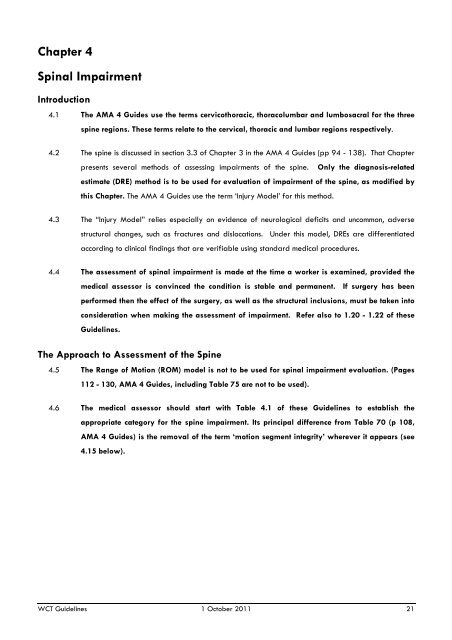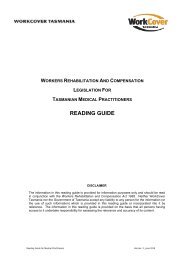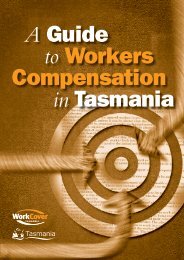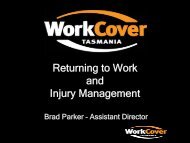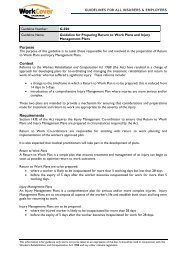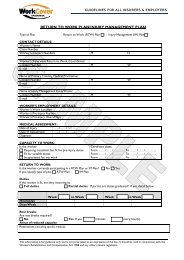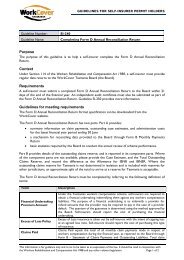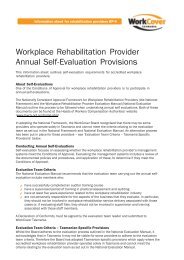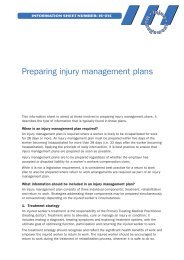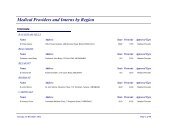Guidelines for the assessment of permanent impairment Version 3
Guidelines for the assessment of permanent impairment Version 3
Guidelines for the assessment of permanent impairment Version 3
Create successful ePaper yourself
Turn your PDF publications into a flip-book with our unique Google optimized e-Paper software.
Chapter 4Spinal ImpairmentIntroduction4.1 The AMA 4 Guides use <strong>the</strong> terms cervicothoracic, thoracolumbar and lumbosacral <strong>for</strong> <strong>the</strong> threespine regions. These terms relate to <strong>the</strong> cervical, thoracic and lumbar regions respectively.4.2 The spine is discussed in section 3.3 <strong>of</strong> Chapter 3 in <strong>the</strong> AMA 4 Guides (pp 94 - 138). That Chapterpresents several methods <strong>of</strong> assessing <strong>impairment</strong>s <strong>of</strong> <strong>the</strong> spine. Only <strong>the</strong> diagnosis-relatedestimate (DRE) method is to be used <strong>for</strong> evaluation <strong>of</strong> <strong>impairment</strong> <strong>of</strong> <strong>the</strong> spine, as modified bythis Chapter. The AMA 4 Guides use <strong>the</strong> term ‘Injury Model’ <strong>for</strong> this method.4.3 The “Injury Model” relies especially on evidence <strong>of</strong> neurological deficits and uncommon, adversestructural changes, such as fractures and dislocations. Under this model, DREs are differentiatedaccording to clinical findings that are verifiable using standard medical procedures.4.4 The <strong>assessment</strong> <strong>of</strong> spinal <strong>impairment</strong> is made at <strong>the</strong> time a worker is examined, provided <strong>the</strong>medical assessor is convinced <strong>the</strong> condition is stable and <strong>permanent</strong>. If surgery has beenper<strong>for</strong>med <strong>the</strong>n <strong>the</strong> effect <strong>of</strong> <strong>the</strong> surgery, as well as <strong>the</strong> structural inclusions, must be taken intoconsideration when making <strong>the</strong> <strong>assessment</strong> <strong>of</strong> <strong>impairment</strong>. Refer also to 1.20 - 1.22 <strong>of</strong> <strong>the</strong>se<strong>Guidelines</strong>.The Approach to Assessment <strong>of</strong> <strong>the</strong> Spine4.5 The Range <strong>of</strong> Motion (ROM) model is not to be used <strong>for</strong> spinal <strong>impairment</strong> evaluation. (Pages112 - 130, AMA 4 Guides, including Table 75 are not to be used).4.6 The medical assessor should start with Table 4.1 <strong>of</strong> <strong>the</strong>se <strong>Guidelines</strong> to establish <strong>the</strong>appropriate category <strong>for</strong> <strong>the</strong> spine <strong>impairment</strong>. Its principal difference from Table 70 (p 108,AMA 4 Guides) is <strong>the</strong> removal <strong>of</strong> <strong>the</strong> term ‘motion segment integrity’ wherever it appears (see4.15 below).WCT <strong>Guidelines</strong> 1 October 2011 21


